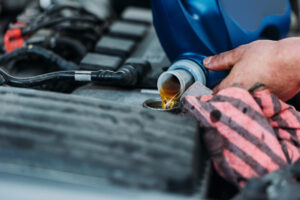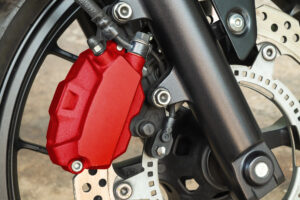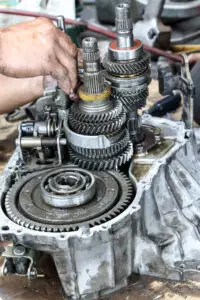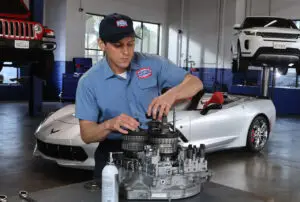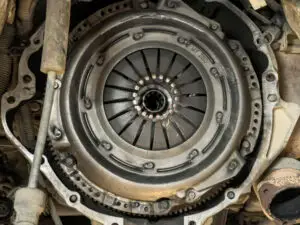You likely know the basics: the transmission in your vehicle helps shift gears and is either a manual or an automatic. But how does it work? How do the various types of transmissions differ in their operation? And how can you help keep your transmission running smoothly? The answers to these questions are both simple and complex. The internal mechanics of any transmission involve many individual components working perfectly together — and keeping the system healthy depends on regular maintenance, as well as choosing the right driving habits.
Common Types of Transmissions & How They Operate
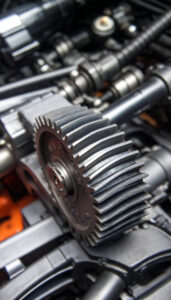
Automatic Transmissions
Classic automatic transmissions are hydraulic systems. They depend on the teamwork of sensors and hydraulics to operate. The engine and vehicle’s speed are both monitored by sensors so that the control unit can determine which gear ratio is necessary. Small valves called solenoids open or close to direct the flow of transmission fluid, helping to facilitate gear shifts and full engagement. A separate component, the torque converter, sits between the engine and transmission to transfer power to the gears and out to the drive wheels.
Manual Transmissions
In manual transmission vehicles, gears are selected by the driver rather than sensors and a control unit. The clutch is positioned between the flywheel, engine, and transmission. It controls the transfer of power from the engine, disengaging during gear shifts to prevent stalling. Using a shifter in the cabin of the car, the driver selects which gear to engage, therefore adjusting how much torque is sent out. A synchronizer ring matches the gear ratio to the speed of the drive shaft, which connects the transmission to the drive wheels.
Dual Clutch Transmissions
Though they’re classified as automatic transmissions, dual clutch systems operate differently than the classic engineering. The goal of dual clutch transmissions is to make gear shifts smoother and increase efficiency. Essentially, two gears are selected at the same time on different clutches — one clutch controls odd-numbered gears and the other controls even-numbered gears. Your vehicle will pre-select the next gear so that engagement of one happens at the same time as disengagement from the previous gear. This avoids interruption of power flow to the drive wheels, maintaining a more steady speed.
Continuously Variable Transmissions
Another variation is the continuously variable transmission (CVT). This system is also automatic, not requiring the driver to shift gears. However, rather than using the defined gear ratios that classic automatic or dual-clutch transmissions do, CVTs use a cone and pulley system that offers an infinite number of gear ratios. One pulley is connected to the engine and the other to the wheels – as the diameter of one gets larger, the other gets smaller. This increases efficiency as it tends to be lighter than other transmissions, leads to a smoother ride, and optimizes fuel economy.
How to Keep Your Transmission Running Smoothly
Efficient transmissions require many individual components to work easily together and stay synchronized. How can you help keep your transmission running smoothly, no matter which type of system is in your vehicle? Maintenance services like fluid changes and your driving habits each time you sit behind the wheel make a difference in the health of your transmission.
Keep Up with Regular Maintenance Services
Proper transmission fluid level and condition is essential. Especially in automatic transmissions, fluid helps pressurize and lubricate the system, allowing for full and easy gear engagement and preventing friction that can speed up wear or cause overheating. In general, plan to have your transmission fluid changed every 50,000 miles, but your owner’s manual has more specific recommendations for your car. The fluid in manual transmissions should be changed more often than automatic transmissions, but your driving habits and the climate where you live will also have an impact.
Avoid Towing or Hauling Excessive Weight
One way to speed up wear or damage your transmission is carrying too much weight for your vehicle. Your owner’s manual should have a recommended weight limit. By staying within that range, you avoid putting too much strain on both the transmission, engine and suspension. Plus, hauling too much weight can also impact handling while you drive, making it more difficult to steer and slow your car.
Be Mindful of When You Shift Gears
Though it’s more apparent with manual transmissions than automatics, it’s important to pay attention to timing when shifting gears. If you’re driving a manual, you’re probably familiar with the grinding sound that can happen when you get the timing off of when to press and release the clutch pedal. In automatic transmission vehicles, be sure your car isn’t moving when you shift between Park and Drive. This limits the strain put on your transmission as you shift, especially when reversing the direction of motion for your car.
Trust the Transmission Experts at Your Local Chicagoland AAMCO
When it’s time for your next transmission service — or you just have questions about your car — a visit to the experts at your local AAMCO will help keep you in the right lane to optimize efficiency and ensure a smooth ride. Our mechanics know the ins and outs of how your transmission operates, no matter what type it is. Schedule your appointment with us today!
For more tips on maintaining your vehicle, check out our guide on essential car maintenance tips.

